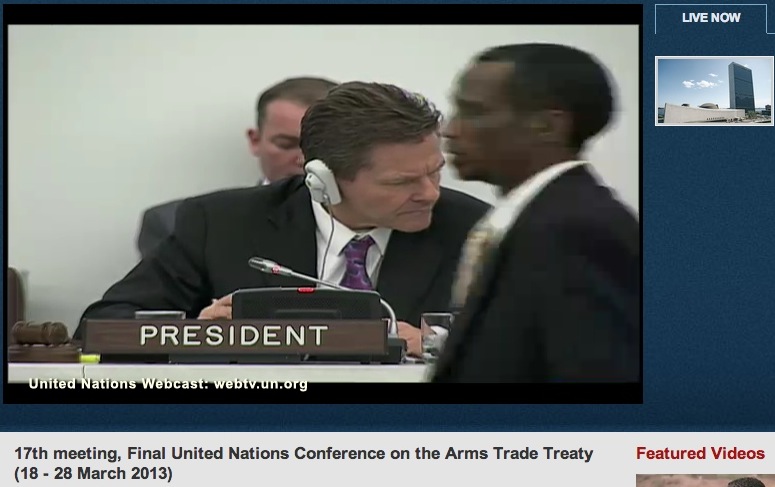Since 2010, Human Rights Watch has been calling on governments to review the 30-year-old international protocol on incendiary weapons to better protect civilians, but its message sharpened considerably ahead of the annual meetings of the Convention on Conventional Weapons held at the United Nations in Geneva on 14-15 November 2013. “Where’s the outcry?” the non-governmental organization asked as it issued a report documenting more than 50 Syrian government attacks using incendiary weapons since November 2012. Continue reading Outrage at Syria’s incendiary weapons use
|
||||
|
A breach of protocol occurred at the United Nations on 21 October, when applause erupted from the civil society gallery high up at the back of the newly renovated meeting room where the General Assembly’s First Committee on Disarmament and International Security was meeting. It came as New Zealand’s Ambassador Dell Higgie read the full list of 124 nations that had endorsed a joint statement expressing support for a humanitarian process on nuclear weapons. Continue reading 2013 disarmament committee highlights On Monday, 14 October 2013, the Chemical Weapons Convention entered into force for the Syrian Arab Republic, where hundreds of civilians were killed by the weapons less than two months earlier. The arrival of the convention’s 190th state party caps off a remarkable month for international efforts to eradicate chemical weapons and marks another milestone in what has been a busy year for advocates of humanitarian disarmament. Continue reading Chemical weapons ban in the spotlight Over the past year, the Syrian government has used missiles, air-dropped bombs, mortars, rockets, artillery and other explosive weapons with wide-area effects, causing multiple civilian casualties and destroying homes and communities. Due to the nature of the weapons and the locations targeted, these kinds of attacks kill and injure civilians, damage infrastructure, and leave behind explosive remnants of war. Many now agree that it is now time for action to curb the use of explosive weapons with wide-area effects in populated areas. Continue reading Curbing explosive weapons in populated areas Less than one week after the launch of a new international Campaign to Stop Killer Robots, a new UN report has called for a moratorium on “Lethal Autonomous Robotics,” weapons that would be able to select and attack targets without any human intervention. Continue reading United Nations the next stop for killer robots Something remarkable happened at the United Nations in New York on Thursday evening (March 28), when member states failed to adopt a long-sought treaty to regulate the arms trade. Politicians “deplored” the way in which agreement on the Arms Trade Treaty text had been “thwarted” by three of the world’s most abusive regimes: Iran, Democratic People’s Republic of Korea (DPRK), and Syria. UN Secretary-General Ban Ki-moon expressed “disappointment,” describing the failure as a “setback.” Yet despite the bluster this apparent defeat is in reality a double-win for everyone in favour of the Arms Trade Treaty and working to advance humanitarian disarmament. It’s also a great example of how international law can be achieved when sustained civil society pressure ensures governments stick to the plan and do what they have committed to do. Continue reading Busting consensus while staying in the UN On 4-5 March 2013, a highly-anticipated conference to consider the humanitarian impact of nuclear weapons was convened by Norway in Oslo. This write-up covers some of the highlights from this latest humanitarian disarmament initiative, which seeks to reframe the debate on nuclear weapons in humanitarian terms and initiate swift action by like-minded states in support of the abolition of nuclear weapons. Continue reading The humanitarian impact of nuclear weapons 2013 looks set to be a busy year (as always) for the community of governments and non-state actors seeking to advance humanitarian disarmament, with events including the final Arms Trade Treaty negotiations, a conference to consider the humanitarian impact of nuclear weapons, and the launch of a new campaign to stop killer robots. They take place against a backdrop of continued conflict and armed violence in several countries, decreasing aid levels (including for humanitarian mine action), and a perpetually ‘broken’ United Nations (UN) disarmament machinery. Continue reading Advancing humanitarian disarmament in 2013 On 16 January 2013, representatives of French NGOs working in the field of humanitarian disarmament held a day-long seminar in Paris to discuss on this new approach to international diplomacy and campaigning. Panel discussions looked at lessons learned and challenges ahead, impacts of the campaigns to ban landmines and cluster bombs, and France’s role. Continue reading Le désarmement humanitaire en France On the occasion of the 20th anniversary of the International Campaign to Ban Landmines, 90 representatives from non-governmental organizations and global coalitions gathered in New York for a Humanitarian Disarmament Campaigns Summit convened by Human Rights Watch. The Summit Communiqué issued by 31 signatories calls for strong disarmament initiatives driven by humanitarian imperatives to strengthen international law and protect civilians. The Communiqué was delivered to the United Nations High Representative for Disarmament Affairs Ms. Angela Kane and distributed to government representatives attending the UN General Assembly First Committee on Disarmament and International Security. A PDF of the Communiqué is available in English and French. The full text and list of signatories is also reprinted below. Continue reading Humanitarian Disarmament Campaigns Summit |
||||
|
Copyright © 2025 Ministry for Disarmament - All Rights Reserved Powered by WordPress & Atahualpa |
||||










